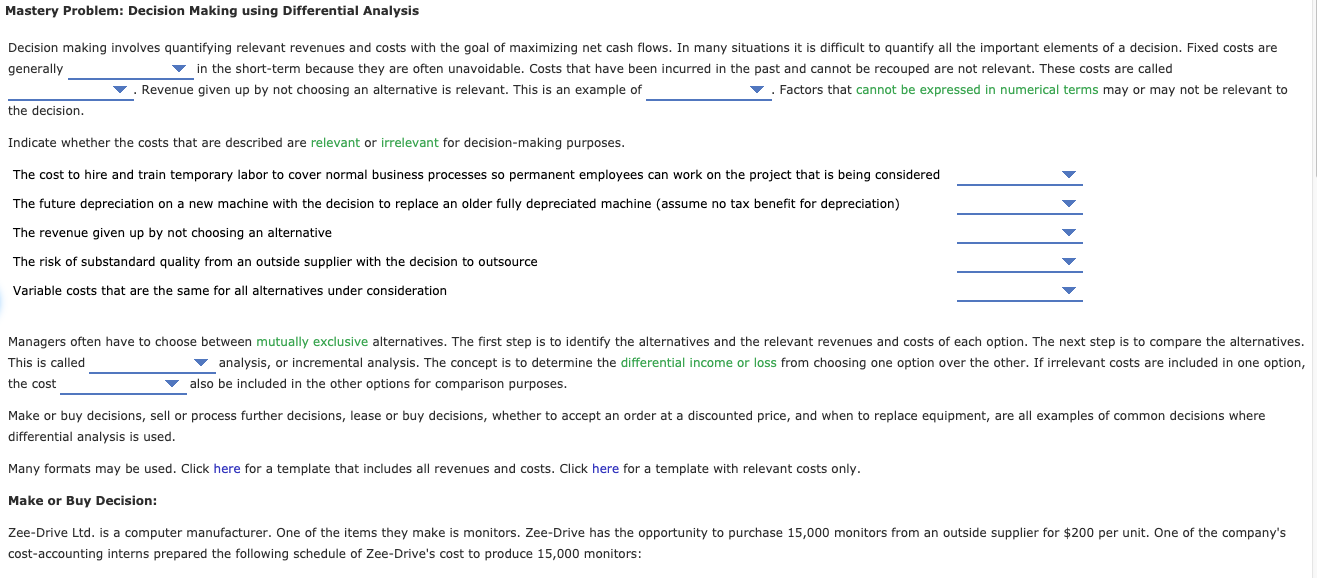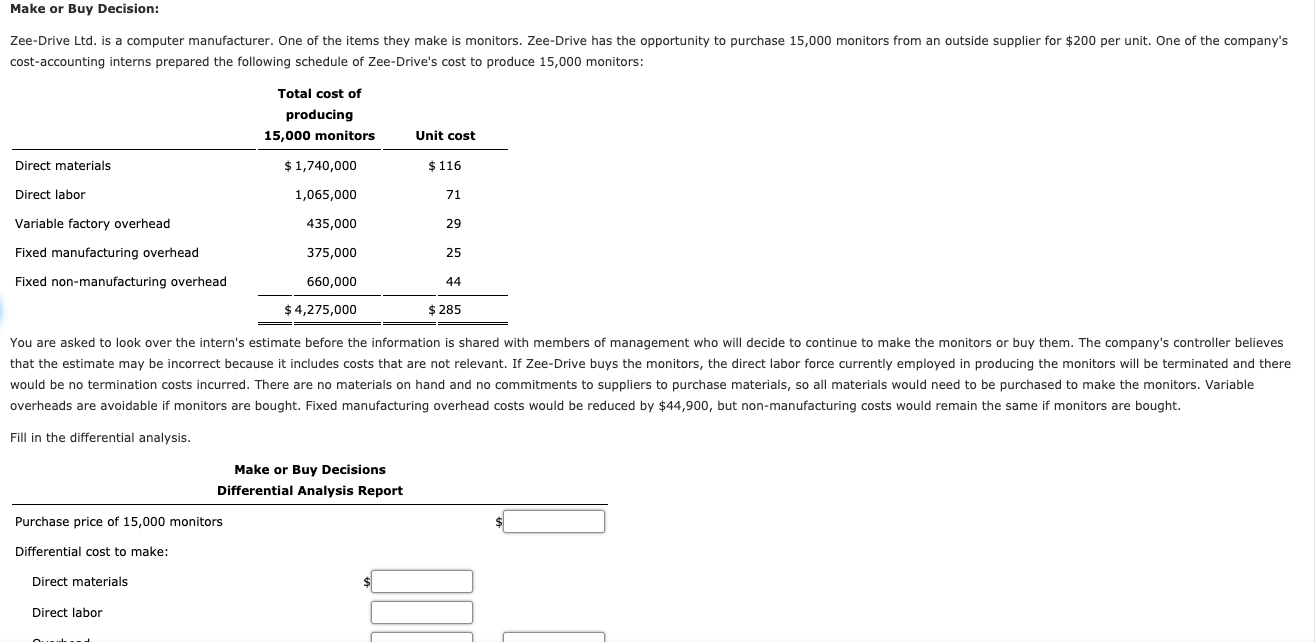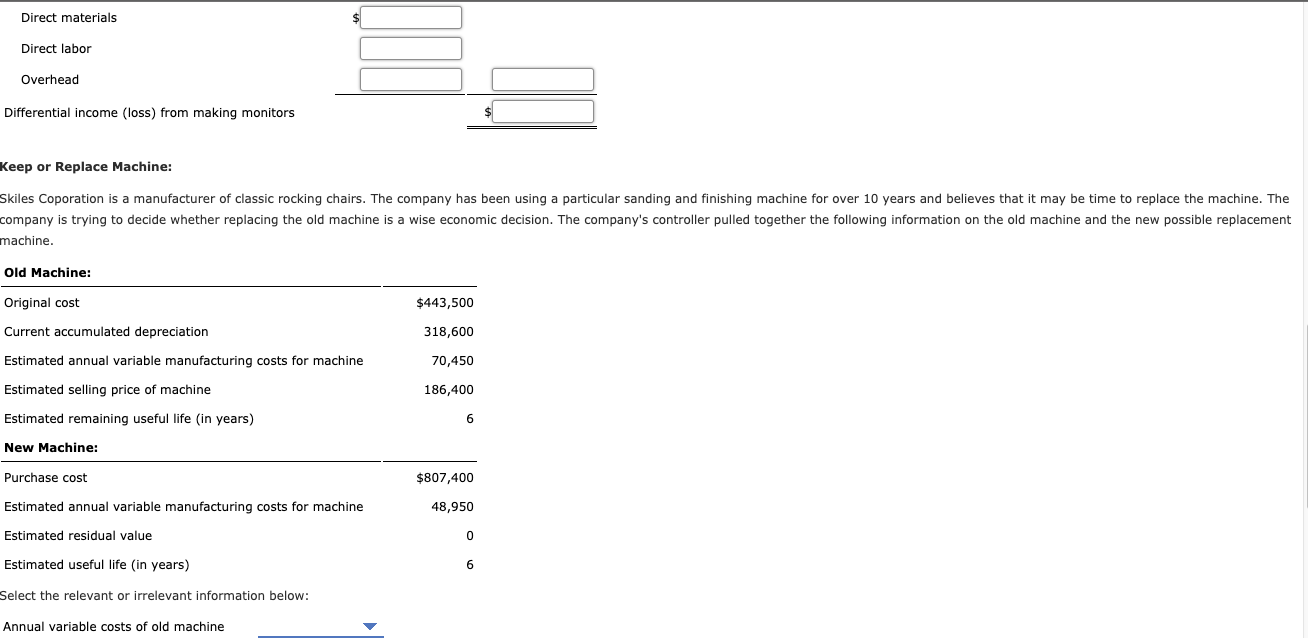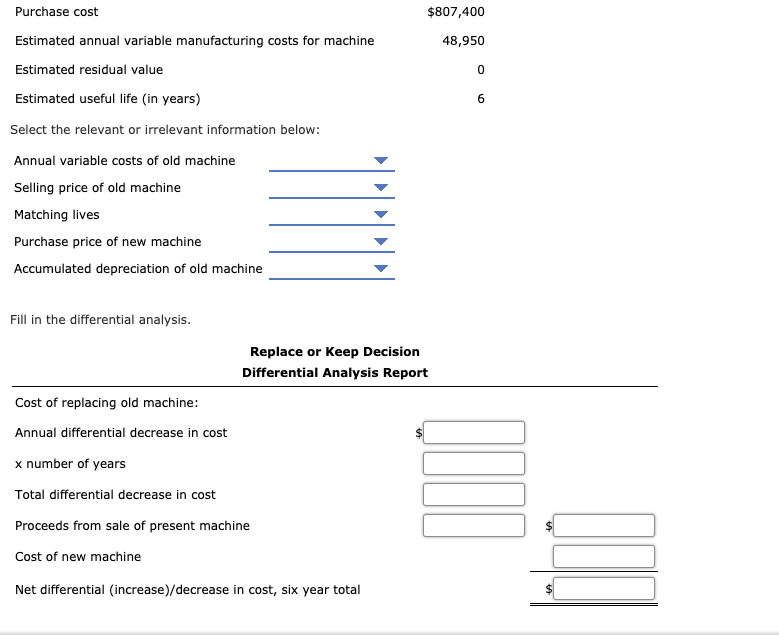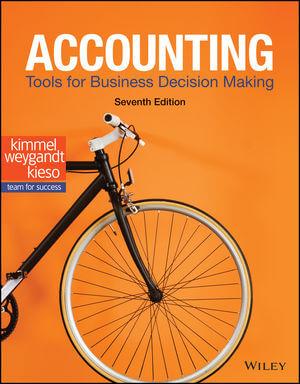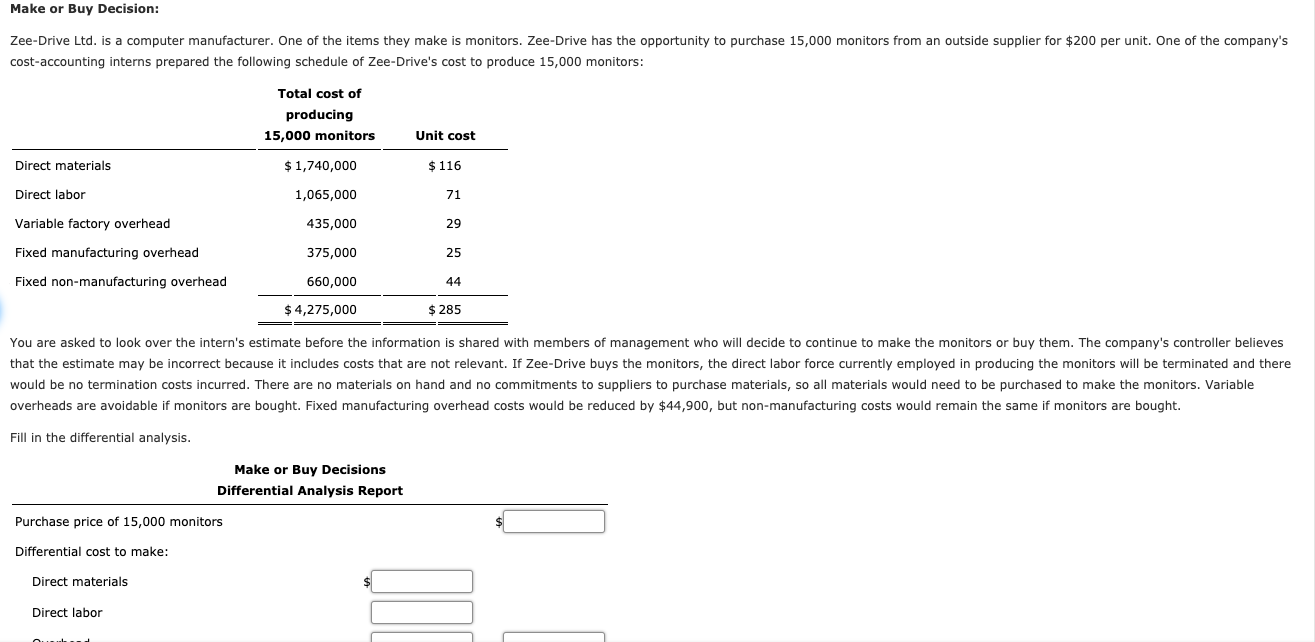
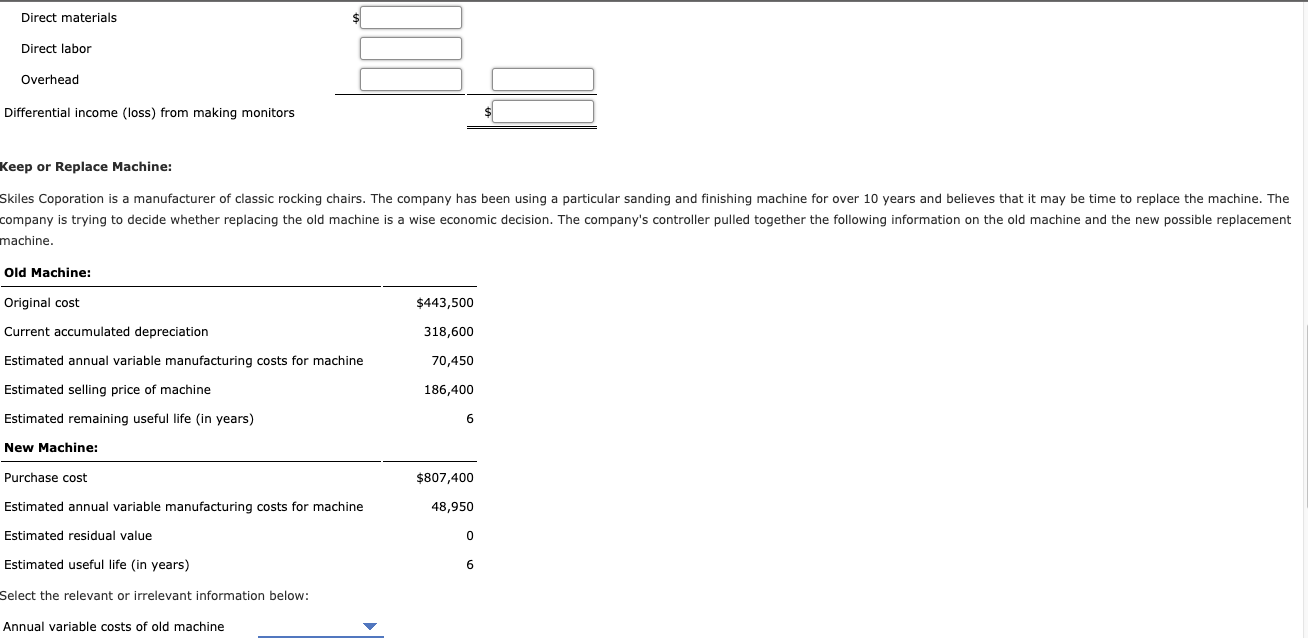
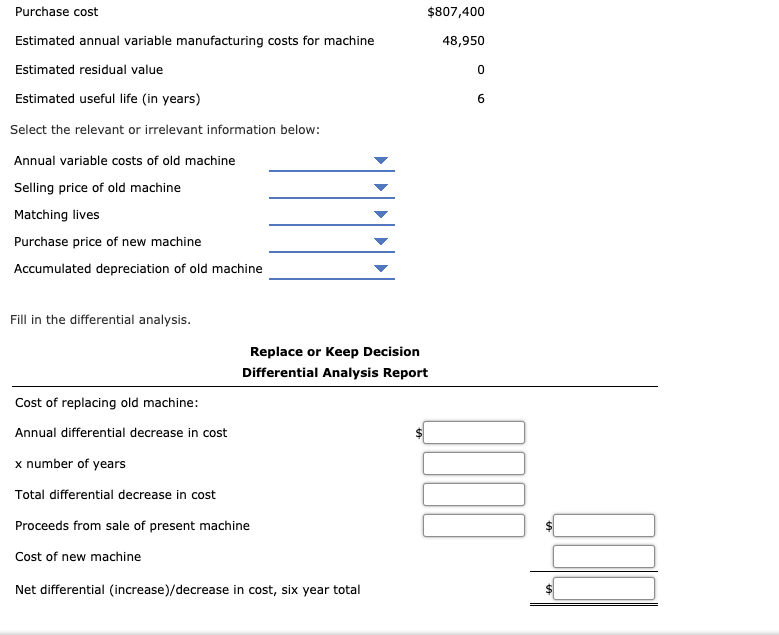
Please help! :)
Mastery Problem: Decision Making using Differential Analysis Decision making involves quantifying relevant revenues and costs with the goal of maximizing net cash flows. In many situations it is difficult to quantify all the important elements of a decision. Fixed costs are generally in the short-term because they are often unavoidable. Costs that have been incurred in the past and cannot be recouped are not relevant. These costs are called . Revenue given up by not choosing an alternative is relevant. This is an example of . Factors that cannot be expressed in numerical terms may or may not be relevant to the decision. Indicate whether the costs that are described are relevant or irrelevant for decision-making purposes. The cost to hire and train temporary labor to cover normal business processes so permanent employees can work on the project that is being considered The future depreciation on a new machine with the decision to replace an older fully depreciated machine (assume no tax benefit for depreciation) The revenue given up by not choosing an alternative The risk of substandard quality from an outside supplier with the decision to outsource Variable costs that are the same for all alternatives under consideration Managers often have to choose between mutually exclusive alternatives. The first step is to identify the alternatives and the relevant revenues and costs of each option. The next step is to compare the alternatives. This is called analysis, or incremental analysis. The concept is to determine the differential income or loss from choosing one option over the other. If irrelevant costs are included in one option, the cost also be included in the other options for comparison purposes. Make or buy decisions, sell or process further decisions, lease or buy decisions, whether to accept an order at a discounted price, and when to replace equipment, are all examples of common decisions where differential analysis is used. Many formats may be used. Click here for a template that includes all revenues and costs. Click here for a template with relevant costs only. Make or Buy Decision: Zee-Drive Ltd. is a computer manufacturer. One of the items they make is monitors. Zee-Drive has the opportunity to purchase 15,000 monitors from an outside supplier for $200 per unit. One of the company's cost-accounting interns prepared the following schedule of Zee-Drive's cost to produce 15,000 monitors:Make or Buy Decision: Zee-Drive Ltd. is a computer manufacturer. One of the items they make is monitors. Zee-Drive has the opportunity to purchase 15,000 monitors from an outside supplier for $200 per unit. One of the company's cost-accounting interns prepared the following schedule of Zee-Drive's cost to produce 15,000 monitors: Total cost of producing 15,000 monitors Unit cost Direct materials $ 1,740,000 $ 116 Direct labor 1,065,000 71 Variable factory overhead 435,000 29 Fixed manufacturing overhead 375,000 25 Fixed non-manufacturing overhead 660,000 44 $ 4,275,000 $ 285 You are asked to look over the intern's estimate before the information is shared with members of management who will decide to continue to make the monitors or buy them. The company's controller believes that the estimate may be incorrect because it includes costs that are not relevant. If Zee-Drive buys the monitors, the direct labor force currently employed in producing the monitors will be terminated and there would be no termination costs incurred. There are no materials on hand and no commitments to suppliers to purchase materials, so all materials would need to be purchased to make the monitors. Variable overheads are avoidable if monitors are bought. Fixed manufacturing overhead costs would be reduced by $44,900, but non-manufacturing costs would remain the same if monitors are bought. Fill in the differential analysis. Make or Buy Decisions Differential Analysis Report Purchase price of 15,000 monitors Differential cost to make: Direct materials Direct laborDirect materials $:] Direct labor :] Differential income (loss) from making monitors 5:] Keep or Replace Machine: Skila Copcration is a manufacturer of classic rocking chairs. The company has been using a particular sanding and nishing machine for over 1.0 years and believes that it may be time to replace the machine. The company is trying to decide whether replacing the old machine is a wise economic decision. The company's controller pulled together the following information on the old machine and the new possible replacement machine. Old Machine: Original cost $443,500 Current accumulated depreciation 318,600 Estimated annual variable manufacturing costs for machine 70,450 Es'dmated selling price of machine 186,400 Esmated remaining useful life (in years) 6 Purchase cost $807,400 Esmated annual variable manufacturing costs for machine 48,950 Estimated residual value 0 Estimated useful iife {in years) 6 Select the relevant or irrelevant information below: Annual variable costs of old machine V Purchase cost $807,400 Estimated annual variable manufacturing costs for machine 48,950 Estimated residual value O Estimated useful life (in years) Select the relevant or irrelevant information below: Annual variable costs of old machine Selling price of old machine Matching lives Purchase price of new machine Accumulated depreciation of old machine Fill in the differential analysis. Replace or Keep Decision Differential Analysis Report Cost of replacing old machine: Annual differential decrease in cost x number of years Total differential decrease in cost Proceeds from sale of present machine Cost of new machine Net differential (increase)/decrease in cost, six year total



